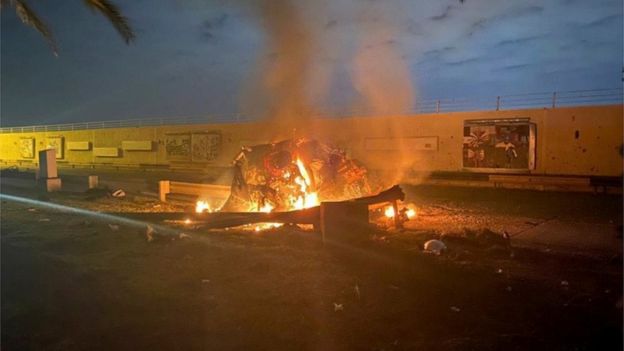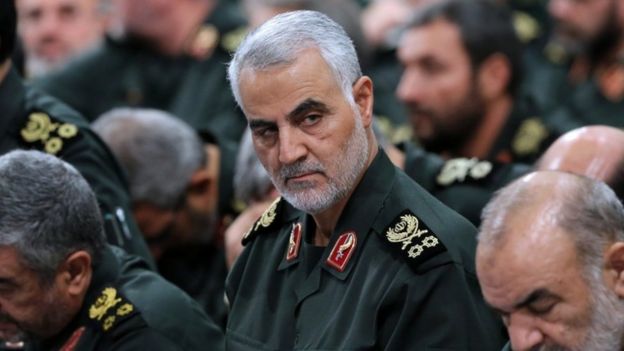A huge crowd in Iraq’s capital Baghdad is taking part in a funeral procession for the Iranian military commander Qasem Soleimani, who was killed in a US airstrike on Thursday.
Soleimani was the architect of Iran’s Middle East operations and Iran vowed to take “severe revenge” for his death.
The gathering in Baghdad on Saturday marked the beginning of days of mourning for Soleimani.
His body is to be returned to Iran for a funeral and burial in his home town.
The crowds in Baghdad were also there to mourn the death of Abu Mahdi al-Muhandis, an Iraqi who commanded the Iranian-backed Kataib Hezbollah group and effectively led the Popular Mobilisation units – an umbrella of militias in Iraq dominated by groups aligned with Iran.v
Mourners started gathering in Baghdad from the early hours, ahead of the start of the procession, waving Iraqi and militia flags and chanting “death to America”. The procession snaked though the streets, some carrying portraits of Soleimani and some of Iran’s supreme leader, Ayatollah Ali Khamenei.
Reports said the bodies of the Iranians would then be flown on Saturday evening to Iran, which has declared three days of mourning for the murdered general. His funeral is to be held on Tuesday in his hometown of Kerman in central Iran.
Some Iraqis, conversely, celebrated in Baghdad’s streets at the news of Soleimani’s death. He was accused of orchestrating violent crackdowns on peaceful pro-democracy protests there in recent months.



The priority for Iran’s leaders now is to send a very strong message about how much Qasem Soleimani mattered.
He mattered in terms of being the most important military official for Iran, the most important intelligence official, one of the most important political personalities. They now want to see massive funerals, massive processions through the streets of major Iranian cities.
The aim is to solidify Qasem Soleimani’s status as a martyr. It is clear from all of the signs that he already had cult hero status among his forces. They want that symbolism to live on, to make him as powerful in death as he was in life.

Fresh airstrikes in Iraq
Iraqi state television said on Friday there had been another air strike in the country, 24 hours after the killing of Soleimani. An Iraqi army source told the Reuters news agency that six people were killed in the new strike, which hit a convoy of Iraqi militia in the early hours of Saturday morning local time.
A US military spokesman denied that the American-led coalition fighting in the region was responsible.
“FACT: The Coalition @CJTFOIR did NOT conduct airstrikes near Camp Taji (north of Baghdad) in recent days,” said Colonel Myles Caggins III, in a post on Twitter.
The United States said it had deployed an additional three-thousand troops to the Middle East to help respond to any backlash from the strike.

Speaking at a news conference at his Mar-a-Lago resort in Florida, the US president, Donald Trump said: “The United States military executed a flawless precision strike that killed the number one terrorist anywhere in the world, Qassem Soleimani.”
Mr Trump said Soleimani was “plotting imminent and sinister attacks on American diplomats and military personnel but we caught him in the act and terminated him”.
But Trump administration officials did not give any details about what planned attacks had prompted them to move quickly to kill Soleimani. Both President Barack Obama and President George Bush rejected a strike on the general as too risky.
The US state department issued a warning in the wake of the strike, advising American citizens to leave Iraq immediately via any means possible.
How did Iran react?
In a statement following Soleimani’s death, the Supreme Leader Ayatollah Ali Khamenei said: “His departure to God does not end his path or his mission, but a forceful revenge awaits the criminals who have his blood and the blood of the other martyrs last night on their hands.”

Simmering US-Iranian hostilities had escalating rapidly last week after the US conducted air strikes in Iraq and Syria against an Iran-backed Iraqi militia, which the blamed for an earlier rocket attack that killed a US civilian contractor. Pro-Iranian militia attacked the US Embassy in Baghdad in response.
In a letter to the UN Security Council, responding to the strike on Soleimani, Iranian ambassador Majid Takht Ravanchi said that Iran reserved the right to self-defence under international law. Analysts said Iran could deploy cyber-attacks against the US, or attempt to strike US military targets or interests in the Middle East.
How does Iraq fit into this?
Iran supports a variety of Shia militia groups in neighbouring Iraq. Soleimani had just arrived at Baghdad airport and was travelling in a convoy alongside officials from such militia when their cars were hit by several US missiles.
Al-Muhandis, the Iraqi militia leader who was also killed in the strike, commanded the Kataib Hezbollah group – also backed by Iran.
Iraq now finds itself in a difficult position as an ally both of Iran and of the US. Thousands of US troops remain in the country to assist in the broader struggle against the Islamic State (IS) group. But the Iraqi government insists that the US has acted beyond the terms of this agreement.
Prime Minister Adel Abdul Mahdi labelled the missile strike as a “brazen violation of Iraq’s sovereignty and a blatant attack on the nation’s dignity”. Iraq’s parliament announced that it would hold an emergency meeting on Sunday. The US State Department warned Americans in Iraq to leave “immediately”.
Who was Qasem Soleimani?
The 62-year-old was widely seen as the second most powerful figure in Iran, behind Supreme Leader Ayatollah Ali Khamenei. The Quds Force, an elite unit of the Iranian Revolutionary Guard Corps (IRGC), reported directly to the ayatollah, and Soleimani was hailed as a heroic national figure.

He was widely considered an architect of Syrian President Bashar al-Assad’s war against rebels in Syria, the rise of pro-Iranian paramilitaries in Iraq, the fight against the Islamic State group, and many battles beyond.
Charismatic and often elusive, the silver-haired commander was revered by some, loathed by others, and a source of myths and social media memes. He had emerged in recent years from a lifetime in the shadows directing covert operations to achieve fame and popularity in Iran, becoming the subject of documentaries, news reports and even pop songs.
Under his 21-year leadership of the Quds Force, Iran bolstered Hezbollah and other pro-Iranian militant groups in Lebanon; expanded its military presence in Iraq and Syria; and orchestrated Syria’s offensive against rebel groups in that country’s long civil war.
Credit: Source Link